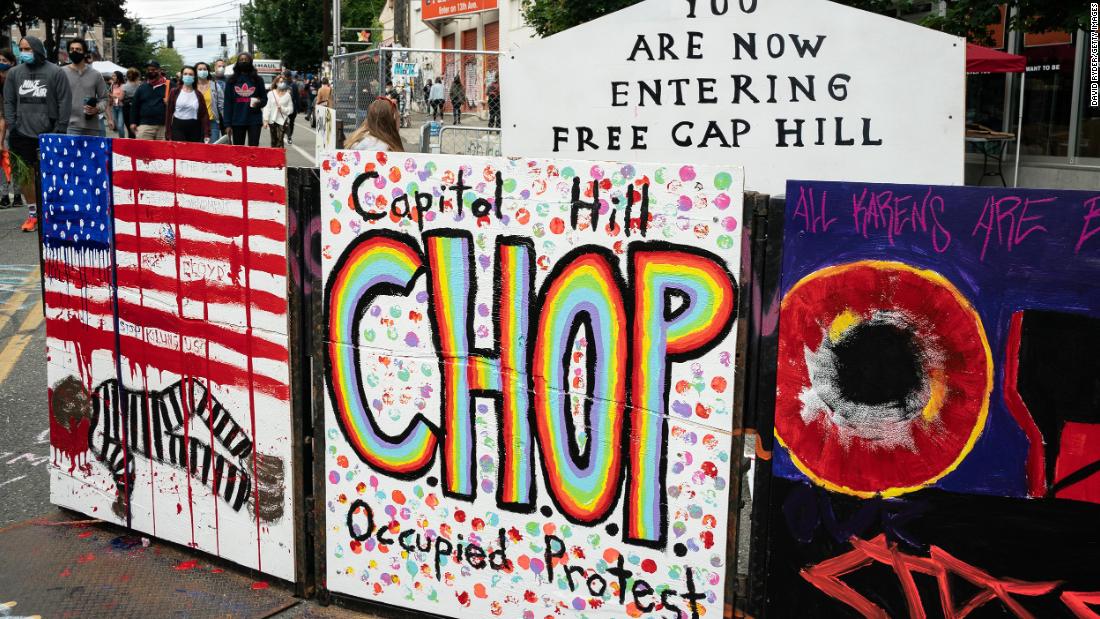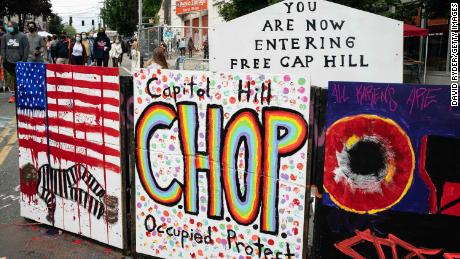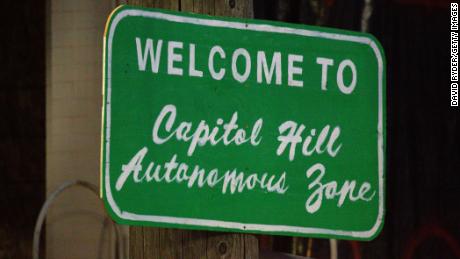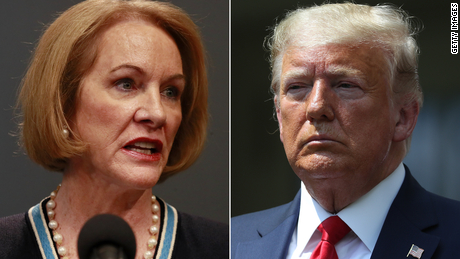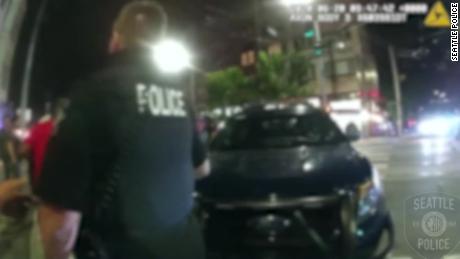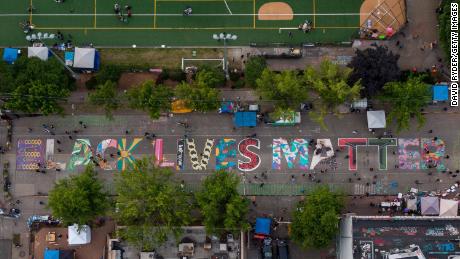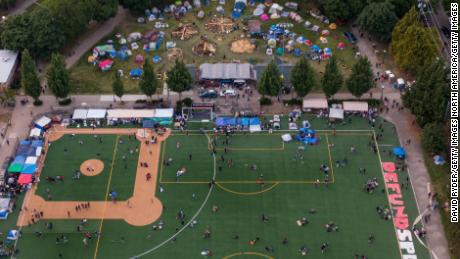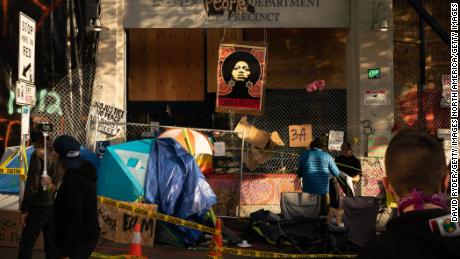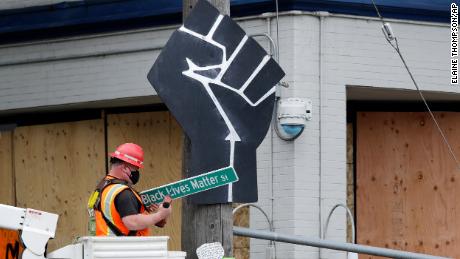They envisioned a world without police. Inside Seattle’s CHOP zone, protesters struggled to make it real
But she is not going to miss the protest. “The CHOP was really good for a week,” said J.R.P., who did not want her name published for fear she’d be fired from her job. “The last two weeks it’s been turned into a militant cult.”
Protesters wanted to end police violence against Black people by defunding the department by 50%. They argued armed officers shouldn’t be called to respond to issues of mental health, homelessness, poverty. But once they created a police-free zone, they immediately had to deal with all those issues and more — with only the donated time and supplies of fellow protesters, who still had day jobs. With police absent from the 6-square-block area, the experiment spun out of control, with accusations that it ended up causing exactly what it had aimed to stop: more violence against Black people.

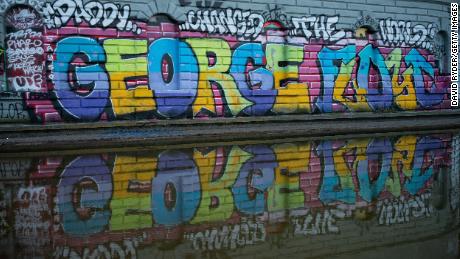
Graffiti bearing the name of George Floyd is seen June 24 in Cal Anderson Park in the CHOP.
“I was there the first night the police left,” Tarika Powell said. Someone put a microphone and speaker outside the police building, and people talked about the change they wanted to see. She said they were unified on ending police brutality.
“There’s nowhere else in the city where you have people coming together in conversations with one goal,” she said. “And that was one of the things that made it so wonderful and so appealing.”
Then, someone put up a sign: Capitol Hill Autonomous Zone. It’s not clear which came first, the collective desire to set up the zone or the sign declaring it. But signs began popping up, and they were outrageous, and that made them funny. An official-looking traffic sign appeared on one corner: “Alt Route Exit 1312. Free Capitol Hill — Last Exit.”
The first weekend of the CHOP had a kind of magical quality, where you could walk up to anyone and start talking. It didn’t matter if they were kids or anarchists or old people, people dressed as wizards or as a giant pink pile of breasts.
“One of the really awesome things about the space, before the shootings started, was it brought together people from all over Seattle,” said Powell of Black Collective Voice, a group of organizers who met in CHOP. “Even though Seattle is a very liberal place, it’s divided by race and class. But there in CHOP you had people from various class and racial backgrounds coming together and supporting one cause.”
On the cold Tuesday night of June 16, around 1 a.m., we found a couple dozen young people partying around a bonfire in a dry fountain. They were drunk and happy. We said we were journalists and showed our badges. A guy drinking from a red Solo cup grabbed it, held it to his hip, and said, “If I had this, I’d be walking around this place like” and then began strutting theatrically.
He also had an assignment for us. He pointed to the dozens of tents now planted on the lawn of Cal Anderson Park and whispered, “Who are these people??” He’d been playing basketball here his whole life, he said, and now the park was filthy. Why were people growing crops in it? Pointing to the garden, he posed the same question we’d already been asked by two other protesters: “When did Black people say they needed more vegetables?”
It was a good question. Some protesters had urged others not to treat the scene as a party so as not to detract from the message of defunding the police. Still the CHOP grew bigger every day: a free clothing site, free food tents, late-night dodgeball, a “no cop co-op.”

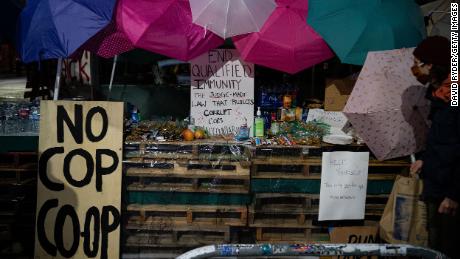
A pop-up shop with free snacks, water and other items is seen June 9 near the Seattle Police Department’s East Precinct.
Volunteer medics, with training that ranged from first aid to professional nursing, had a couple tents in the parking lot of a taco restaurant. People passed out free masks to control the spread of Covid-19, and most people wore them, at least until the late-night party vibe took over. Protesters built gardens to plant crops, which a Seattle Public Utilities worker said was a problem because the park was on top of the watershed; she made them promise not to use nitrates. An urban farmer said he was going to graft the branches of fruit trees onto the park’s trees so homeless people could just reach up and get something to eat.
But one of the most peculiar developments was the improvised security team. There were constant rumors that White power groups were just hours away, ready to bring violence. A cloud of paranoia hung over the protest. So, a defense operation evolved, with members often dressed in all black, carrying walkie-talkies, sometimes wearing balaclavas and occasionally body armor.
The main security group was called the Sentinels, assisted by various leftist armed groups, who generally described themselves as offering protection for oppressed people from violence by the state, not as a replacement for government-vested power. Because maintaining a perimeter required organization and constant communication — and that left behind something of a paper trail — the security team also became one of the clearest ways to trace the evolution of the CHOP and its demise.
A “plan of action” from the Puget Sound John Brown Gun Club, an anti-fascist organization, offered tips on de-escalation: Respond to nonviolence with nonviolence. If someone is being physically violent, the plan advised “either de-escalate, use less lethal force to subdue, or leave the area.” Do not respond with lethal force unless someone is using lethal force, it says. “Don’t be a cop.” Avoid answering reports of “Property damage or its prevention (we’re not cops).”

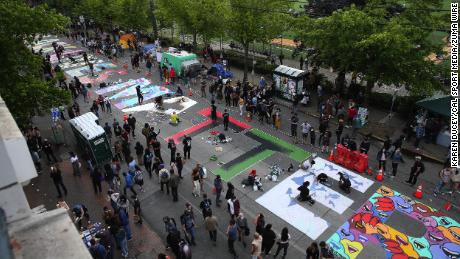
Artists paint a streetwide sign that says Black Lives Matter over several blocks on June 11 in the CHOP.
Some police saw protesters as vulnerable
Police saw the abandonment of the East Precinct as a humiliation, according to a Seattle police officer CNN spoke to a couple days after it happened. He did not want to be named because talking to journalists is against department policy.
He was shocked at how quickly public opinion had turned. “The city council is hostile to the police department,” he said. “The public turned against us.” The protest chants were personal. Even his Facebook friends were posting memes about police brutality. “My friends say, ‘We need more cops like you. You’re one of the good ones,'” he said. “I don’t know what that means. I’m one of the normal ones.”
“I think that we have a really good police department in this city, and people would rather believe we’re fascists than that we have a good police department that sometimes has to be police,” the officer said.
“What I want police reformers to understand is, if you’re trying to make someone do something they don’t want to do, you’re eventually going to have to use force. You cannot de-escalate your way out of everything.” He added, “It’s always going to look bad.”
The police officer did not like the CHOP, but he worried the protesters were sitting ducks. On June 12, Seattle police officers were sent an email saying they should not respond to calls within the CHOP unless it was a “mass casualty event,” like an active shooter or a structural fire.
“Everybody loves firefighters and hates cops,” he said. “But they won’t go in unless we go in.”
That meant paramedics wouldn’t go in either. In just over a week, this problem would no longer be theoretical.

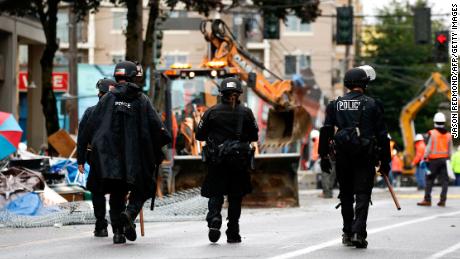
Seattle police walk past debris and bulldozing equipment near the East Precinct on July 1 after police cleared the CHOP.
Threats, from errant drivers to drug crises
“In the beginning, we were there to look out for vehicles charging into the crowd,” said Slate, who eventually led the security group and uses only a pseudonym.
Then, it got more and more complex — mental health calls, drug crises. Someone changed their group chat name to Sentinels, they said, and it felt good to formalize what they did. Slate became a leader, with a man who called himself James Madison his second in command. Black Collective Voice member Javi Cordero donated $400 worth of walkie-talkies. The John Brown Gun Club came in to help.
Their authority was “reputation-based,” Slate said, unlike the police, who got their authority by representing the government. The Sentinels had to “maintain our reputation with the community so they respect us.” There was a communications tent and training on how to use the radios.
But, Slate said, “the situation just kept changing, and getting crazier and crazier and crazier.”
Within a couple days, a Sentinels volunteer saw “a major fistfight that turned bloody. … I attempted to draw people away to give medics space to no avail.” A few days later, the volunteer was responding to dozens of calls. “There were several fist fights, a man who had snuck into the backyard of a Capitol Hill resident, and a large motorcycle gang rolled through that made my heart jump. It turned out that they were there to help with the barricade.”
In the middle of the night in the first week, a white SUV started swerving through the CHOP, and people shouted to get out of the way. After a previous incident of a man driving into protesters and shooting a person in the arm, it seemed like a serious threat, and a crowd chased after the vehicle, someone yelling, “Get his ass!” When it stopped at a barricade inside the CHOP, a crowd pulled the door open. But the driver was not a White power terrorist, just an apparently drunk guy. They let him go.
Some protesters dealt with provocateurs with wit. On June 13, a man in a Trump shirt and khaki shorts began marching through the field with an American flag. People were angry and shouted at him, someone stole his flag and his MAGA hat, then someone else returned his flag and his hat. An elderly man told the crowd not to yell and curse at him, and people hugged, and then finally Steffon Riggins, who’d been there protesting since the fights with police, just bought the guy’s flag for $60. The man left, and Riggins stood in the center of the CHOP’s main drag, the American flag draped over his shoulders.

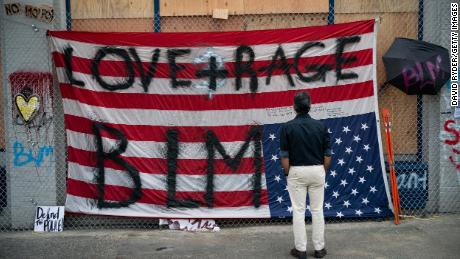
A man views an upside down US flag at the Seattle Police Department’s vacated East Precinct on June 14 in the CHOP.
The power of de-escalation was repeatedly tested. In the park, a man experiencing homelessness set up a grill in the tent city, and called it something like “Klay’s Kommunity Kitchen,” Madison said. “He wrote KKK in grease,” Madison said, “and he stood by that.” An angry crowd formed, and the security team had to figure out how to de-escalate it. They eventually got the crowd to disperse, got the man to shut down his grill and clean off the KKK, and then called in a mental health volunteer. “We tried to not be the police but keep the peace.”
One morning, at about 6:30 a.m., protester Michaud Savage saw two men running down the street. “These homeless White dudes just start beating the s**t out of each other. I’m like, ‘What do I even f**king do?'” Savage said. He said he and others de-escalated the situation, and the men moved along. “But I don’t have training in that. I’m just a person.”
One security volunteer who works as a social worker saw several clients in the CHOP. Over time, the tents in Cal Anderson Park housed more and more people who were otherwise homeless. Cordero estimated 40% to 60% of tent city residents were homeless in the late days of the CHOP. Black Collective Voice had decided to keep a “safe distance,” he said, “because the CHOP is too large, too unstable, too dangerous a problem for one group to address, and it has been fundamentally thrown to the wolves by the city, in not providing the resources to keep it safe.”

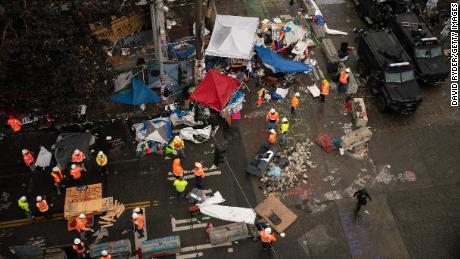
City crews on July 1 dismantle the CHOP.
Protesters said they felt they’d been expected to solve society’s most difficult problems on their own. “People within the city are aware that it has long had a large population of people who have drug and mental health issues and who are homeless, who are not receiving any services from the city,” Powell said.
“There’s always been a population of those individuals around Cal Anderson” Park, Powell said. “The city of Seattle has continually failed them. Now, they use that population as a political ploy against CHOP.”
The city blamed the CHOP for creating social and criminal problems that existed already, then said those problems would be fixed if police returned, she said. Mayoral spokeswoman Kamaria Hightower said, “While Cal Anderson does have a history of people experiencing homelessness camping on the grounds, I think the timeline and Executive Order make clear that protecting demonstrators, those living on site, the residents in the area, and employees of local businesses from the escalating gun violence was the reason action had to be taken.” Powell asked, “How can we solve this problem within two weeks that you have failed to solve with decades of time and hundreds of millions of dollars in resources?”
This perspective was shared by police. “We’re being asked to do way too many societal issues,” Mike Solan, the president of the Seattle police union, said. “That puts a lot of pressure on us as just human beings, but overall, in society, to have an answer, a solution, for everything we might encounter.”
The police chief “has repeatedly spoken of her dedication to holistic policing,” SPD spokeswoman Sgt. Lauren Truscott said, and the department works with regional partners on “mental health, substance abuse, and other root factors in crime that go beyond policing.”

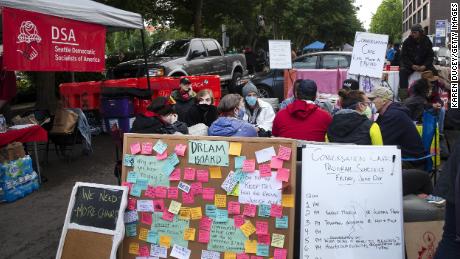
People hang out in the Conversation Cafe on June 12 in the CHOP.
Shots ring out and tensions spike
Police released body cam video of them responding to the scene. An angry crowd shouts that the victims had already been taken to the hospital.
The shock of the first shooting, Slate said, was that people in the CHOP had expected paramedics to enter the zone if someone was seriously hurt. They were wrong. “That was wiped clean after the first (shooting),” Slate said. “But it cost a human life.”
The CHOP medics left their tent near the taco restaurant parking lot. He added, “We lost a significant number of riot medics because the nature of the injuries started changing. Not all of them are ready to have a man die on their hands.” According to protesters, the John Brown Gun Club left, too.
The next day, on Sunday evening, a third person was shot in the arm. He was 17. There was a vigil after the first shooting. “There were a number of people present who were relatives or friends of the shooting victim,” said one protester who attended. “Based on hearing what they have said, it does appear that there is a connection to some sort of gang violence.”
Asked if the CHOP shootings were gang-related, Truscott, the SPD spokeswoman said, “We do not normally discuss open/active investigations.” Mayor Jenny Durkan in a July 1 news conference said, “We don’t know yet enough about those shootings to determine exactly who did it.”
But within CHOP security group chats, there was frequent discussion that gangs were involved, warning of gang escalation and the presence of “gangbangers.”
The messages reveal the increasing danger of late-night CHOP. In voice memos circulated in one security group chat, someone reports, “We’re seeing multiple armed people — non-right-wingers — hanging around.” Another warns, “We have a couple of armed groups here trying to hold things down, but I would recommend that if you are not armed you stay away. If you are not armed and maybe even not armored, I would stay away.”
There was another shooting early on the morning of June 23. The next day, the Sentinel security team left the CHOP. Walkie-talkies were handed over to a new team. “We’d already made our peace with the fact that there were some things we weren’t able to handle,” Slate said. “You can’t be a target if you’re not there. You can’t make a bad decision if you’re not there.”
Slate said after the June 21 shooting, he was crouched behind a concrete barrier with Madison. “I got a rifle in my hand, he’s got a rifle in his hand, and I said I really wish this were just a war zone. It’d be so much simpler.” They wouldn’t have to worry about legality, gangs, or mental health.

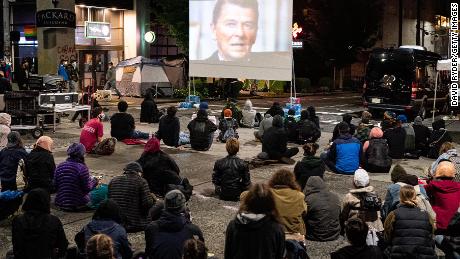
People watch a screening of “13th,” a documentary film by director Ava DuVernay, on June 9 in the CHOP.
The Sentinels sign off
On June 29 at 3 a.m., a 14-year-old and a 16-year-old were shot in a car at a CHOP barricade. The 16-year-old was killed. The younger victim was hospitalized. Accounts of how it happened conflict. But videos from the moment show people running at the sound of gunfire. A voice memo sent to a CHOP security group said, “Shots fired. May have been from our end, toward car coming in through barricades, barreling in through barricades.” Messages to security groups say the car was driving either in or around the CHOP, and that people guarding the barricades shot into it.
In one video, when gunshots pause, someone shouts, “So, you’re not dead yet huh?” In a CHOP safety group text, someone wondered who said it. Another person replied, “God that was f**king haunting.”
“I saw two kids shot from my balcony,” J.R.P. said. Her boyfriend tackled her and pulled her and their dogs into a closet. “It was gunfire for two minutes straight.” She’d been able to watch as the security situation evolved. “The nice ones left and the bad ones showed up,” she said. “It went from daisies to barbwire.”
She and her neighbors had talked about creating a support group for people who lived through it all, so they could smoke cigarettes and drink coffee and talk about the surreal experience with people who really get it. No one else understands.
The Sentinels bailed, too. They heard rumors they were targets of retaliation after the 16-year-old was killed. Slate told them to stop going to the CHOP. A security volunteer explained, “A lot of people I know are not down for continuing to be part of something where we don’t know if we’re being used as pawns or not.”
But they had collected evidence with gloves and little plastic baggies. Madison said he had a meeting with homicide detectives later. “The thing that really sucks is that we have to cooperate to some degree,” Slate explained. “Otherwise we’re accessories and that’s a crime itself. And that’s not our objective.”
“It’s not CHOP’s fault,” Slate said. “Violence is not born out of what CHOP did. Violence moved to CHOP. But Lorenzo is dead because of the CHOP because Lorenzo was in the CHOP. … You can’t say it’s a non-factor in his death.”
The protesters had to reckon with the CHOP changing the character of the neighborhood and the city, he said. “If Black lives really matter, why are we still here potentially risking the lives of more Black people?”
“I think it’s very important for us as activists not to fall into the conversation that blames ‘Black on Black’ violence,'” Powell said. “The mayor and Seattle Police Department are using these men’s deaths for political ends. I don’t believe they would care or mention it if they could not use it as a political weapon against CHOP.”
The police “department routinely deploys significant resources whenever there are spikes in crime in a concentrated area,” Truscott, the SPD spokeswoman, said. “Our department also relentlessly investigates homicides in our city.” The mayor’s office pointed to its “Reimagining Police” memo, which outlines how the city “has taken initial steps rooted in community demands to address policing and is committed to working towards lasting change.”

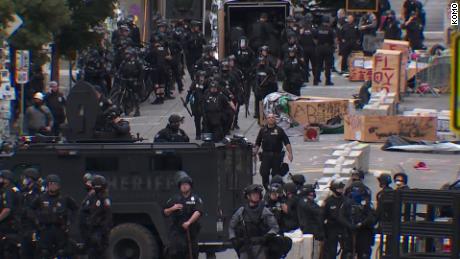
Seattle police, at right, look on as Department of Transportation workers remove barricades Tuesday at the CHOP.
“Although the violence is coming from outside CHOP, we reject the invitation to disparage these young men,” Powell said. “People who are involved in gang activity are usually involved in that activity because they are poor and they do not see any means of not being poor besides engaging in criminal activity,” she said. The protests were about “White supremacy and capitalism,” she added, and, “they are victims of the same system.”
At a “decompression” gathering over the weekend, security volunteers got together with their masks off. It was emotional, and some people cried. “It was a nice opportunity to talk to people freely, because there’s lots of paranoia in CHOP because people could be listening or livestreaming you,” a security volunteer said. Slate said, “People were like, ‘We didn’t know what you looked like with your mask off.’ I thought, ‘Oh s**t, I’ve been a robot this whole time.'” He’d been a uniform and not a person.
![]()


